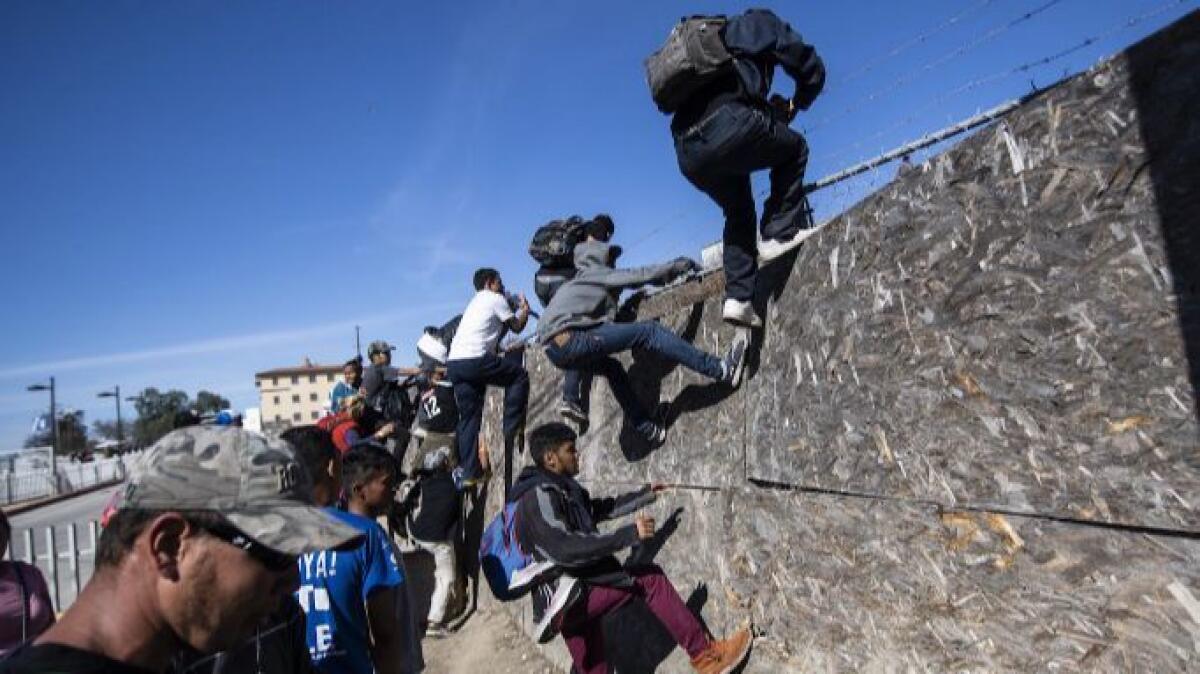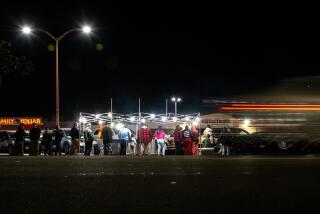The number of immigrants in the U.S. illegally is the lowest in more than a decade, a new study finds

- Share via
The number of immigrants in the U.S. illegally dropped to the lowest in more than a decade in 2016, according to a new report.
Tuesday’s report from the Pew Research Center analyzed census and immigration data to estimate that in 2016 there were 10.7 million immigrants in the U.S. illegally.
The number is 1.5 million less than its peak in 2007.
The center crunched its numbers by subtracting the number of foreign-born people living in the country legally from the total foreign-born population and adjusting with estimated numbers for the many immigrants in the country illegally who do not respond to government surveys. It included more than 1 million immigrants who are temporarily in the country legally under the Deferred Action for Childhood Arrivals and Temporary Protected Status programs because the future of such protections is unclear under the Trump administration.
The decline comes from a sharp drop in the number of Mexicans residing in the country illegally, even as the population of Central Americans illegally crossing the border or overstaying visas has grown.
“Mexico is still the dominant birth country” for immigrants in the country illegally, “but the explanation for the decline has a lot to do with Mexico,” said D’Vera Cohn, who co-wrote the report. “We think the decline in the number of unauthorized immigrants was almost entirely due to fewer Mexicans entering the country without authorization.”
The number of Mexicans in the U.S. illegally dropped 1.5 million from 2007 to 2016, the report said, leaving Mexican nationals to make up about half of the immigrants in the U.S. without permission. In the same time period, the number of Central American immigrants in the U.S. illegally increased by 375,000. Pew found 1.85 million Central Americans to be residing in the country illegally, with a significant number from El Salvador, Guatemala and Honduras.
The decline in the share of Mexicans among the people in the U.S. illegally is due to the “dramatically different living conditions” in Mexico compared with its southern neighbors, said Randy Capps, director of research for U.S. programs at the nonpartisan Migration Policy Institute, who was not involved in the study.
Over the long term, Mexico’s economy has improved and its birth rate has declined, leaving fewer people interested in job opportunities in the north, especially after the U.S. recession a decade ago. Capps said migration from Mexico was historically dominated by young men coming to the U.S. alone, while Central American immigrants today tend to come as families. Honduras, Guatemala and El Salvador, he added, have in recent years experienced “higher rates of violence, much more poverty and much lower per capita income” than Mexico, leading people to flee north.
Pew did not look at data from 2017 because the American Community Survey, the U.S. Census Bureau’s ongoing population estimate, came out as the Pew report was close to completion. But Pew researchers said they expected the trend of decreases in the Mexican population to continue even as the Central American population increased.
Because the report does not look at 2017 or this year, researchers could not say what effect the Trump administration has had overall on the number of immigrants in the country illegally.
During his campaign, the president vowed to deport all immigrants living in the U.S. illegally, suggesting he could do so through military-style roundups similar to those authorized by President Eisenhower in 1954 that led to mass deportations of Mexicans. President Trump, who has faced criticism for demonizing immigrants in the U.S. illegally by broadly painting them as rapists and killers who “infest” the country, has also continued to demand the construction of an expanded border wall.
“If you look at apprehensions data, it does point to the number of Central Americans increasing, but we can’t say what’s happening overall,” Cohen said. “Many people from other countries overstay visas rather than cross the border without authorization.”
Border apprehensions dropped during the first year of Trump’s presidency to the lowest number since 1971. Since then, they have increased. Last month, Border Patrol agents arrested or rejected for admission 60,745 people attempting to enter the U.S. at the Mexico border, according to U.S. Customs and Border Protection. The number is the highest it’s been since Trump became president. The increase was due in part to high numbers of Guatemalans and Hondurans fleeing violence.
RELATED: Migrants decide on next move as tensions in Tijuana heighten »
Experts caution that it is difficult to draw conclusions from border apprehension and admission rejection numbers. Over the years, U.S. Customs and Border Protection has alternated between reporting decreases in border apprehensions as either a measure of border agents doing badly or doing well at their jobs.
Deportations have not reached the levels they did during the Obama administration. In the fiscal year that ended in September, the government ordered 287,741 deportations, according to the Transactional Records Access Clearinghouse at Syracuse University. In the 2013 fiscal year under the Obama administration, there were 438,421 deportations.
Pew researchers said that although deportations have had an effect on the number of immigrants in the country without permission, the numbers of migrants attempting to enter or stay in the country illegally to begin with is a bigger reason for the decline. Overall, the number of immigrants in the country illegally dropped by 13% between 2007 and 2016.
Pew found “statistically significant” declines from Brazil, Colombia, Ecuador, Korea and Peru. But in addition to those from Central American countries, the number of immigrants from India and Venezuela in the U.S. illegally also grew during that period.
Researchers at Pew also concluded that visa overstays were increasingly the source of new immigrants in the country illegally.
“Among unauthorized immigrants in the center’s estimates who arrived in the previous five years, the share who are likely to be people who overstayed their visas probably grew substantially between 2007 and 2016 — to the point where they probably constituted most of the recent unauthorized immigrant arrivals in 2016,” the report said.
Although the total number of immigrants in the country illegally declined in those nine years, the number in the U.S. legally grew by more than 6 million, or by 22%, according to the report. There were about 34.4 million immigrants in the country legally in 2016.
The report also broke down numbers of immigrants in the country illegally by state. A dozen saw declines of 10,000 or more since 2007. That included a drop of 550,000 in California to 2.2 million and 240,000 in Florida to 775,000. Three states saw increases in the same period. In Maryland, the number of immigrants there illegally grew by 25% to 60,000. In Massachusetts, the increase was nearly 14% to 35,000, and in Louisiana it was a 27% jump to 15,000.
UPDATES:
3 p.m.: This article was updated with a comment from Randy Capps and details on visa overstays rising as a source of new immigrants in the country illegally.
This story was originally published at 2 p.m.
More to Read
Sign up for Essential California
The most important California stories and recommendations in your inbox every morning.
You may occasionally receive promotional content from the Los Angeles Times.











